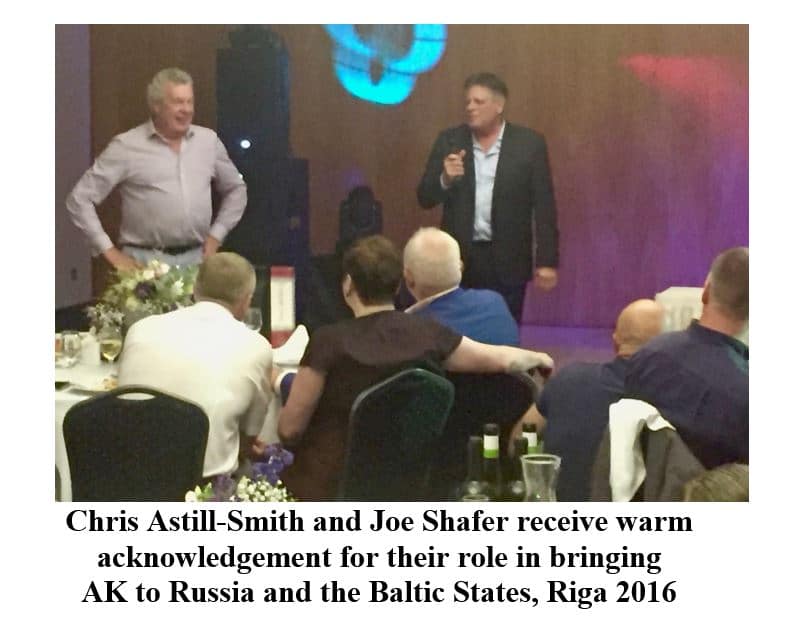…article continued:
Applied Kinesiology in the Baltic States (Balticum)
The history of origins of ICAK Balticum dates back to the end of the 1990s, when Professor Lyudmila Vasilieva first visited Riga.Lyudmila Vasilieva was one of the first graduates of the course, taught by ICAK diplomates Joseph Shafer and Christopher Astill-Smith in Russia in the early nineties.Professor Vasilieva enthusiastically embedded the acquired knowledge into her medical practice, as well as widely advocated it.

A professor of rehabilitation, Zinaida Kasvande, organized her first introductory course in AK together with Professor Vasilieva in Riga. The course immediately became popular among doctors, specializing in manual therapy. Olga Ivanovskaya, Mikhail Petrov, Vladimir Sklyarevich, Anita Dyachenko, Valeriy Kudoyar, Oleg Sukhorukov, Visvaldis Bebrišs, Uģis Beķeris, and many others were amongst the first researchers of a new scientific discipline – applied kinesiology. In order to continue their studies, Sklyarevich, Ivanovskaya, Kudoyar and Sukhorukov headed to Novokuznetsk and Moscow, and completed a course in manual therapy, specializing in basics of AK and muscle testing. The doctors kept on visiting courses in Russia, brilliantly taught by Joseph Shafer, Chris Astill-Smith, John Diamond, and Hans Garten.
A new impulse in the exploration and development of AK in the Baltics was the organization of a basic course in AK in the years 2004-2005 with the participation of German colleagues Wolfgang Gerz and Karmen Kannengeizer. An off-site training course, which took place on the island of Rugen, Germany, rallied the Baltic colleagues based on a common interest in studying AK. In 2005, the foundation of the Baltic society of AK, ICAK Balticum, appeared to be a logical continuation.
With the participation of Estonian doctor Vasiliy Zagura, Lithuanian doctors Alfredas Marushko, Almantas Pocius, Dalus Barakauskas, and others, it was possible to expand the geography of AK and create a department of ICAK of the whole Baltic region. ICAK Balticum. Wolfgang Gerz and Michel Allen were significantly involved, and so were John Diamond, Joseph Shafer, and Tracy Gates, whose motivation helped found ICAK-Balticum.
The foundation of a regional organization in AK allowed a more active participation in ICAK conferences all around the world. One of the highlights is when Valeriy Kudoyar and Oleg Sukhorukov visited Detroit in 2007. The colleagues had an unforgettable time acquiring new experiences and studying emotional sides of the health triad, in a course taught by a prominent psychiatrist, one of Goodheart’s first followers and closest allies, John Diamond, in his New York home.
The doctors were initially impacted by the founding father of AK, George Goodheart, in his home in Detroit, with the active participation of John Diamond. The communication and help of colleagues have supported ICAK-Balticum on its thorny path in mastering AK. On a conference in Amsterdam, Hans Garten, in a private conversation, offered Oleg Sukhorukov to take the ICAK diplomate exam. His offer was motivated by the fact, that, if Oleg, a Russian speaker, were to pass, it would be possible, with translations, for Russian-speaking specialists to pass the exam in their mother language.
Boston, Toronto, Berlin, Bordeaux, and Vienna – these were the geographical stages of passing the exam. After passing the diplomate exam in 2010, Oleg Sukhorukov was accepted into IBE – the examination committee. The exam questions have since then been translated into Russian. Soon, there were new ICAK diplomates: Tatyana Chernishova, Sergey Pilavsky, who passed the exam in the Russian language. Once there are candidates in Latvia, who would want to pass the exam in their mother language, it will facilitate the translation of the exam questions into Latvian.
The organization of regular seminars with the participation of famous specialists, such as John Diamond, Tracy Gates, Joseph Shafer, Chris Smith, Harald Stossier, Jose Palomar and others contributes to the support of interest in AK among specialists in the Baltics on a high level. The success in medical work among the specialists, who have acquired AK, graphically demonstrates the advantages of this comprehensive chiropractic and useful medical discipline. AK is growing in the Baltic states…perhaps helping the chiropractic profession to gain more footing here as well.
With the holding of the 52nd annual ICAK conference “Balance & Harmony” in Riga, Latvia in August 2016, ICAK-Balticum became truly part of the international AK map.
Applied Kinesiology in Australia

The very first Australian exposure to AK started with four undergraduate students at Palmer College in the early 1970s. They were Ian Hope, Mario and Henry Sabella and Donald McDowall. Dr. Goodheart instructed them during his presentations at local chiropractic association meetings in the United States. In their graduation year Mario, Henry and Donald felt confident enough in AK techniques to begin teaching small AK classes at the Palmer College in 1973 and 1974. Dr. Mario Sabella was involved in forming the very first AK Club at Palmer.
Before graduating, Mario Sabella went on to work in Dr. Goodheart’s Detroit practice in the Michigan Building, famous for where Henry Ford made his first car. Dr. Goodheart felt the environment of Henry Ford’s creativity in this building inspired him to innovate.
While Ian Hope was waiting to graduate in 1974, Mario Sabella returned to Australia in 1973 and worked in Ian Hope’s first practice, the Macquarie Chiropractic Clinic in Belconnen, ACT. There, Dr. Mario prepared an AK chiropractic practice for his friend Ian.
Donald McDowall returned home to Canberra in 1974. After working in his father, Keith McDowall’s practice for two years, Donald purchased the Macquarie Clinic from Ian Hope in 1976. Henry and Mario moved to Newcastle, NSW, to establish another AK practice.
Dr. Goodheart gave Donald, Mario and Henry a letter of authority in 1976 to teach his work –via the authority of Australian Chiropractors Association (ACA) and under academic approval of the Phillip Institute of Technology (PIT)–prior to the Chartered Diplomate’s meeting of the inauguration of the ICAK. All profits were given to the Institute to help establish the new chiropractic program. Mario Sabella was the only Australian able to travel to attend the 1976 ICAK foundational meeting in Dearborn, Michigan where he was awarded the Chartered Diplomate status.






